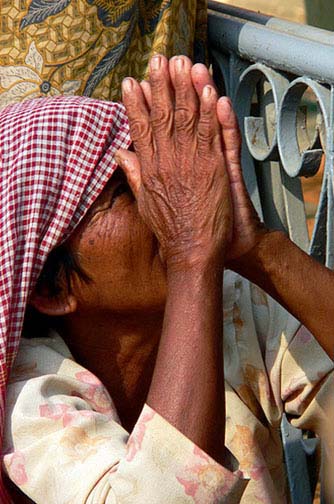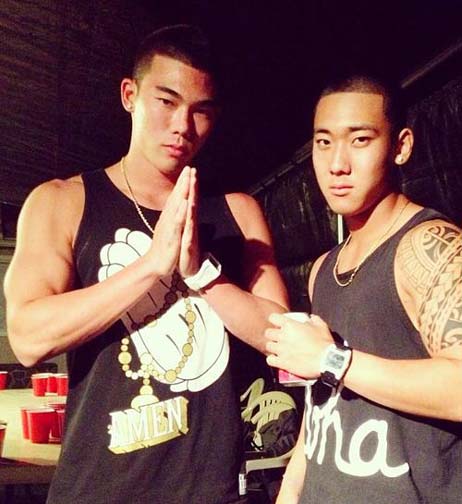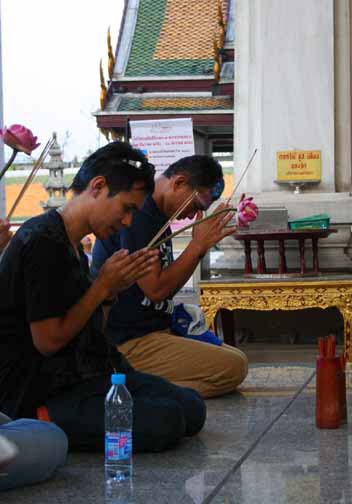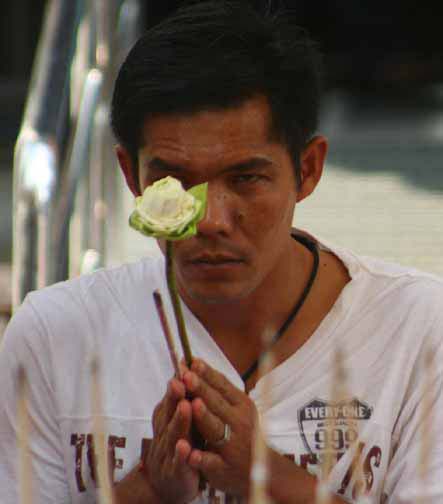Lets all put our hands together – and upside the head of the stupid farang who cruise the streets of Bangkok giving a wai to every Thai they meet. Kids, sex workers, touts, street vendors, service personnel, it doesn’t matter. They are in Thailand. And in Thailand you wai.
No. You don’t.
You idiot.
I cringe each time I see a farang wai in Thailand. And usually roll my eyes and shake my head. Unless I’m in a really good mood. Then I point and laugh. I suppose I should be more generous and just chalk it up to an ignorant touri attempting to echo Thai etiquette. But while the locals will pretty much ignore the effort, it’s a lot like a non-native trying to speak French in France: you’ll do it poorly, the locals really won’t appreciate it, and you’ll come off looking like a fool.
It’s easy to understand the first time visitor to the Kingdom picking up this nasty habit. On Day #1 they’ll be waied to a good hundred times. And the gesture is infectious. Especially when it is accompanied by one of those glorious Thai smiles. How can you not wai back? If they bothered to find out just an ounce of Thai culture before making their trip, however, they’d realize the result of their wai attempt is more like a bitch slap than the gracious gesture they intended it to be. Yes, your mama was right. It never hurts to be polite. But if that is your excuse for improperly using the wai in the kingdom, the polite thing would have been to spend five minutes out of your busy day to learn just a smidgen of local culture before landing in Thailand.
Thai’s are big on saving face and being non-confrontational. So when a touri wais, they will not correct him, scold him, or ridicule him. Besides, that’s what I am here for. Their opinion of said touri, however, will drop quicker than Lindsay Lohan’s panties at a lesbian coke party. And seriously, there is nothing more ridiculous than the fat, dread-headed backpacker bobbing down Khaosan Road giving a wai to every tout, tuk tuk driver, street vendor, bell hop, and whore he passes.
But OK, ignorance amongst the uninitiated can be excused with a laugh. The repeat visitor who has tried to go native, and should know better, is a different story. My problem with these guys is their air of superiority, their desperate desire to demonstrate they are ‘in the know’ when the exact opposite is true. And yeah, I’m talking about the fat old sex tourist who gives a wai to every bar boi he meets. The only time you should ever wai to a bar boi is when his cock is between your palms and you are about to deep throat him.
If you are not Thai it is doubtful you will ever master the intricacies of the wai. What looks like the same gesture to the Western eye, is in reality countless variations on the theme. The level the hands are at, the rigidity of the fingers, the degree of accompanying bow, it all has significance to a Thai. And honestly, you will never get it right.

Beggars often wai in supplication because of their need. As needy as they too may be, sex tourists should not follow suit.
The only time a touri should ever attempt a wai is to a senior monk (both in status and age), a member of the royal family (like you’d ever meet one), a high level member of parliament (see royal family), an elderly person of at least your social status (and since you know nothing about how Thais view social status, mark this one off your list too), possibly your Thai friend’s parents if they are older than you (which is doubtful in the first place, but ask him first anyway and get instructions, too), and to one of those wai giving Ronald McDonald statues (‘cuz it will crack up your Thai friends).
If your mama raised you to be polite, a smile and a nod of the head is an appropriate response when a Thai wais to you. The wrong wai back negates their polite gesture and is akin to a sweet smile while saying, “fuck you”. Because Thais use the wai to pass on that little message too. Just watch the next time a cheap-skate, obnoxious bore staggers out of a gogo bar. Half the staff will wai him. That’s not about Thai graciousness. While their entire hands may be part of that gesture, it’s only their middle fingers that count.
Which you should keep in mind in the event you are confronted with the singular time most visitors ever experience when a wai is not only proper but mandatory. Because while the locals may excuse your other child-like attempts at giving a wai, when The Buddha is the recipient, you better get it right. And 99% of the time your best rule of thumb is the same as it is in giving a wai anywhere else in Thailand: don’t. So let’s cover that first.

All wais are not created equally; knowing what a specific wai means could mean the difference between a happy ending and a not-so happy event.
Showing proper reverence when visiting a temple in Thailand is a must. That doesn’t mean you have to drop to your knees the minute you enter a wat. It does mean that you show the same amount of respect and decorum you would in a house of worship back home (unless your brand of faith involves handling snakes and such). Be quiet, be respectful, don’t interfere with those whose visit is for religious purposes, and don’t be rude. Walking up to the main Buddha statue, having a quick gander, and then turning your back on him and walking away, by the way, is considered rude. Just like striking a crucified pose in front of the altar at a Christian church for a quick selfie would be.
As a visitor, you are welcome to enter pretty much every wat in the country. Unless you are a Buddhist, your role is that of an observer, not a participant. There is no reason for you to kneel. Because you shouldn’t be standing in the middle of a group of locals praying to begin with. There is no reason for you to pray. Because The Buddha is not your god. And if you are one of those who claim to be more spiritual than religious and you feel the need to ‘honor’ the ideal of The Buddha, find a quiet corner away from the locals and give it your best. That will help keep them from interrupting their prayers to ask The Buddha what in the hell that silly farang is up to.
You may however have the good luck and grand misfortune to be visiting a wat with a Thai who actually thinks well of you. And then you really do owe The Buddha a thanks. Said local may very well care about your spiritual well-being and he may also want you to reap the benefits of offering a blessing to Buddha. Or he may just want to reap the benefits of your wallet paying for both of your accruements associated with offering a blessing. Either way, you’ll soon find yourself holding a candle, some incense sticks, and a flower – usually but not always a lotus blossom, or three. If you are truly blessed you’ll also have a piece or two of gold leaf in your hands. Just to help confuse you further.
As nice as it would be for said local to explain what you are supposed to do with all that stuff, he won’t. Anymore than he would tell you how to breathe. You’re supposed to know this crap. And knowing that you know nothing is the first step toward enlightenment. Unlike learning how to wai by watching the gogo bar’s staff’s treatment of obnoxious customers, watching your friend make his offering first is a good rule of thumb. ‘Cuz the intro is seldom the same.
There are a lot of Buddha statues in Thailand, but they are not created equal. Some are more significant than others. Some are in shrines, others in wats. Some wats rank higher in religious significance, as do then their main Buddha statue. And at some temples it’s not only the Buddha that needs proper respect paid. So how you approach will differ from one spot to the next. At most, walking up to the image will suffice. At many, dropping to your knees in front of the image is expected. At some you should be on your knees before making you way toward the image. Which is a bit tricky if you haven’t been born to it. Especially when all the alcohol you consumed the night before has not yet dissipated from your system.
Fortunately the knee-crawl approach requirement is few and far between. When it is, since you are farang, you can walk up, then kneel, and then make one move forward. That still counts. And any demerits you get are probably minor compared to what you did to your karma the night before. In most cases you won’t have to knee-crawl at all. And in many you’ll never have to drop to your knees either. What you will have to do is figure out what to do with all that crap nestled in your hands. And that – thank the Buddha – is almost always the same.
First comes the candle. If it isn’t already lit, use the flame from one already left as an offering to do so. There will be a vessel with lots of burning candles in it already at the altar, and yours goes in the same place. If there is only a candelabra or candle holders and it/they are already filled, just gently knock one out of its spot to make room for yours. ‘Cuz farang candles always rank higher.
Next, it’s flower time. There is often a bucket of water next to the statue to place your flowers in. Sometime not. Regardless, this is not the time to show off your skills as a florist. Place you flowers where everyone else has. Occasionally, usually at a shrine instead of a wat, your only offering will be flowers. If so, move immediately to step #3. If instead you still have the incense and possibly gold leaf to deal with, um, also move immediately to step #3.
Use the flames from the candles you didn’t knock over to light your incense. Hold them between your palms in the wai gesture. Don’t worry about the height you are holding them at – the locals will already be amazed you got this far without screwing it up. Now it is time to pray. Just like right before you blow out the candles on your birthday cake. You can ask for good health. Or world peace. Or to never have to make an offering to The Buddha again. Or if you want to emulate the Thais praying next to you, you can ask for the winning numbers for the next lottery. Like a Catholic priest during confession, The Buddha has heard it all before. And unlike dealing with a Catholic priest, you’ll probably escape without being molested. Which is probably similar to what your boy du jour who accompanied you on your visit to the wat has been praying for.
After praying, while still holding your incense sticks reverently aloft, wai three times. You do so with a slight bow. Then stick your incense in the bucket where everyone else has planted theirs. You can wai/bow one more time after doing so. It’s up to you. If you moved to this step because you only had a flower offering to give, you normally place your flowers and then do the three wai thingy. In either case, now back away from the altar, taking at least one step (two or three is better) before turning your back on the Buddha. And say a quick prayer of thanks for having not screwed up making your offering to Buddha.
But wait! There’s more!
You may still have some gold leaf in your hands if it came with your Buddha offering kit and if you managed to not drop it while trying to accomplish steps #1 through #3. If so, the statue it goes on it will be evident. It’s not Buddhist graffiti, so this is not the time to blaze new trails. Generally, if you have more than one piece of gold leaf, that means there is more than one statue on which you are supposed to affix some. And yes, it really is gold. And no, do not attempt to scrape off a handful to cash in later. The Buddha will not be amused.






On my first trip to Thailand, I had a private tour guide who took me to inside a temple for a “sacred string around the wrist” ceremony. I thought I had my hands in the same position as the tour guide, but the monk seemed upset about something and the guide corrected my hand position (which still seemed the same to me!). Like you, I never wai; however, I do chuckle to myself when I see Ronald McDonald-esque expats wai.
I’ve noticed if one of your hands is holding a large enough denomination of baht, which is where doesn’t matter.
But I do the wai to my family! And occasional wait staff.
Paul
Family: good.
Wait Staff: Tsk, tsk.
🙂
Again, an excellent explanation of an important part of Thai culture, with some good humor thrown in! Fortunately, I am 76 years old, which means most of the time most of the people around me are younger than me. Age has its privileges, and in Thailand, that means I am not expected to wai the youngsters in my midst. Of course in a Thai temple, age does not really matter: Buddha is always the oldest guy there! As to children, when a small child wais me as I drink coffee in the mall, I always just wave back and say hello. The mother smiles, the child imitates my gesture and smiles, and the mother is happy that this old farang didn’t make her and her child lose the merit they gained by wai-ing a farang.
Thanks George, and yep a friendly wave is really all you need do. That’s a gesture understood the world over and one that is always appreciated.
And there is the one-hand-wai. I have seen it a few times, when the wai-ing person has only one hand free.
Is that the one with the middle finger extended?
No middle finger, I am serious. Holding a bag in one hand and moving the other (all fingers stretched out, flat) in position for a wai.
Those kids today.
I haven’t seen that. Even with his hands filled with 50lbs bags of crap ‘we’ just bought, Noom still manages to get both of his up when a wai is required.